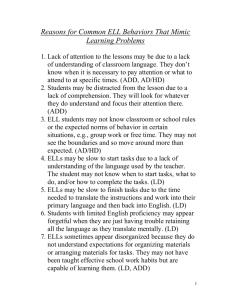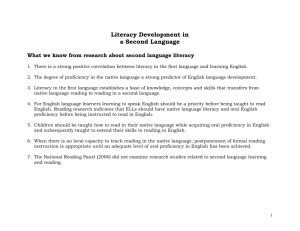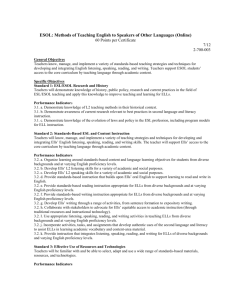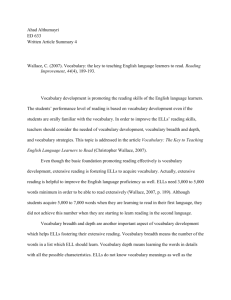ESOL Matrix Template (SLU) - Florida Department of Education
advertisement
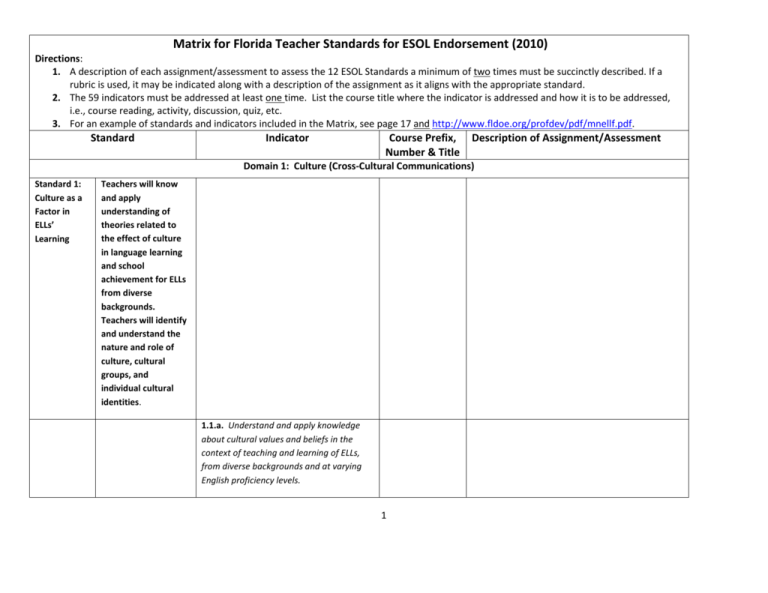
Matrix for Florida Teacher Standards for ESOL Endorsement (2010) Directions: 1. A description of each assignment/assessment to assess the 12 ESOL Standards a minimum of two times must be succinctly described. If a rubric is used, it may be indicated along with a description of the assignment as it aligns with the appropriate standard. 2. The 59 indicators must be addressed at least one time. List the course title where the indicator is addressed and how it is to be addressed, i.e., course reading, activity, discussion, quiz, etc. 3. For an example of standards and indicators included in the Matrix, see page 17 and http://www.fldoe.org/profdev/pdf/mnellf.pdf. Standard Indicator Course Prefix, Number & Title Description of Assignment/Assessment Domain 1: Culture (Cross-Cultural Communications) Standard 1: Culture as a Factor in ELLs’ Learning Teachers will know and apply understanding of theories related to the effect of culture in language learning and school achievement for ELLs from diverse backgrounds. Teachers will identify and understand the nature and role of culture, cultural groups, and individual cultural identities. 1.1.a. Understand and apply knowledge about cultural values and beliefs in the context of teaching and learning of ELLs, from diverse backgrounds and at varying English proficiency levels. 1 1.1.b. Understand and apply knowledge of concepts of cultural competence, particularly knowledge about how cultural identities affect learning and academic progress for students from diverse backgrounds and at varying English proficiency levels. 1.1.c. Use a range of resources in learning about the cultural experiences of ELLs and their families to guide curriculum development and instruction. 1.1.d. Understand and apply knowledge about the effects of racism, stereotyping, and discrimination in teaching and learning of ELLs from diverse backgrounds and at varying English proficiency levels. 1.1.e. Understand and apply knowledge about home/school connections to build partnerships with ELLs’ families (e.g., Parent Leadership Councils (PLC)). 1.1.f. Understand and apply knowledge about concepts related to the interrelationship between language and culture for students from diverse backgrounds and at varying English proficiency levels. Domain 2: Language and Literacy (Applied Linguistics) Standard 1: Language as a System Teachers will demonstrate understanding of language as a system, 2 including phonology, morphology, syntax, semantics and pragmatics; support ELLs’ acquisition of English in order to learn and to read, write, and communicate orally in English. 2.1.a. Demonstrate knowledge of the components of language and understanding of language as an integrative and communicative system. 2.1.b. Apply knowledge of phonology (the sound system), morphology (the structure of words), syntax (phrase and sentence structure), semantics (word/sentence meaning), and pragmatics (the effect of context on language) to support ELLs’ development of listening, speaking, reading, and writing (including spelling) skills in English. 2.1.c. Demonstrate knowledge of rhetorical and discourse structures as applied to second language and literacy learning. 2.1.d. Demonstrate proficiency in English and model for ELLs the use of appropriate forms of English for different purposes. 2.1.e. Identify similarities and differences 3 between English and other languages reflected in the ELL student population. Standard 2: Language Acquisition and Development Teachers will understand and apply theories and research on second language acquisition and development to support ELLs’ learning. 2.2.a. Demonstrate understanding of current and past theories and research in second language acquisition and bilingualism as applied to ELLs from diverse backgrounds and at varying English proficiency levels. 2.2.b. Recognize the importance of ELLs’ home languages and language varieties, and build on these skills as a foundation for learning English. 2.2.c. Understand and apply knowledge of Sociocultural, sociopolitical, and psychological variables to facilitate ELLs’ learning of English. 2.2.d. Understand and apply knowledge of the role of individual learner variables in the process of learning English as a second language. Standard 3: Second Teachers will demonstrate an 4 Language Literacy Development understanding of the components of literacy, and will understand and apply theories of second language literacy development to support ELLs’ learning. 2.3.a. Understand and apply current theories of second language reading and writing development for ELLs from diverse backgrounds and at varying English proficiency levels. 2.3.b. Demonstrate understanding of similarities and differences between L1 (home language) and L2 (second language) literacy development. 2.3.c. Demonstrate understanding of how L1 literacy influences L2 literacy development and apply this to support ELLs’ learning. 2.3.d. Understand and apply knowledge of sociocultural, sociopolitical, and psychological variables to facilitate ELLs’ L2 literacy development in English. 2.3.e. Understand and apply knowledge of how principles of phonology, morphology, syntax, semantics, and discourse affect L2 reading and writing development. 5 Domain 3: Methods of Teaching English to Speakers of Other Languages (ESOL) Standard 1: ESL/ESOL Research and History Teachers will demonstrate knowledge of history, public policy, research and current practices in the field of ESL/ESOL teaching and apply this knowledge to improve teaching and learning for ELLs. 3.1.a. Demonstrate knowledge of L2 teaching methods in their historical context. 3.1.b. Demonstrate awareness of current research relevant to best practices in second language and literacy instruction. 3.1.c. Demonstrate knowledge of the evolution of laws and policy in the ESL profession, including program models for ELL instruction. Standard 2: StandardsBased ESL and Content Instruction Teachers will know, manage, and implement a variety of teaching strategies and techniques for developing and 6 integrating ELLs’ English listening, speaking, reading, and writing skills. The teacher will support ELLs’ access to the core curriculum by teaching language through academic content. 3.2.a. Organize learning around standardsbased content and language learning objectives for students from diverse backgrounds and at varying English proficiency levels. 3.2.b. Develop ELLs’ L2 listening skills for a variety of academic and social purposes. 3.2.c. Develop ELLs’ L2 speaking skills for a variety of academic and social purposes. 3.2.d. Provide standards-based instruction that builds upon ELLs’ oral English to support learning to read and write in English. 3.2.e. Provide standards-based reading instruction appropriate for ELLs from diverse backgrounds and at varying English proficiency levels. 7 3.2.f. Provide standards-based writing instruction appropriate for ELLs from diverse backgrounds and at varying English proficiency levels. 3.2.g. Develop ELLs’ writing through a range of activities, from sentence formation to expository writing. 3.2.h. Collaborate with stakeholders to advocate for ELLs’ equitable access to academic instruction (through traditional resources and instructional technology). 3.2.i. Use appropriate listening, speaking, reading, and writing activities in teaching ELLs from diverse backgrounds and at varying English proficiency levels. 3.2.j. Incorporate activities, tasks, and assignments that develop authentic uses of the second language and literacy to assist ELLs in learning academic vocabulary and content-area material. 3.2.k. Provide instruction that integrates listening, speaking, reading, and writing for ELLs of diverse backgrounds and varying English proficiency levels. Standard 3: Effective Use of Resources and Technologies Teachers will be familiar with and be able to select, adapt and use a wide range of standards-based materials, resources, 8 and technologies. 3.3.a. Use culturally responsive/sensitive, age-appropriate and linguistically accessible materials for ELLs of diverse backgrounds and varying English proficiency levels. 3.3.b. Use a variety of materials and other resources, including L1 resources, for ELLs to develop language and content-area skills. 3.3.c. Use technological resources (e.g., Web,. software, computers, and related media) to enhance language and contentarea instruction for ELLs of diverse backgrounds and varying English proficiency levels. Domain 4: ESOL Curriculum and Materials Development Standard 1: Planning for StandardsBased Instruction of ELLs Teachers will know, understand, and apply concepts, research, best practices, and evidenced-based strategies to plan classroom instruction in a supportive learning environment for ELLs. The teacher will plan for multilevel classrooms with learners from 9 diverse backgrounds using a standardsbased ESOL curriculum. 4.1.a. Plan for integrated standards-based ESOL and language sensitive content instruction. 4.1.b. Create supportive, accepting, student-centered classroom environments. 4.1.c. Plan differentiated learning experiences based on assessment of students’ English and L1 proficiency and integrating ELLs’ cultural background knowledge, learning styles, and prior formal educational experiences. 4.1.d. Plan learning tasks for particular needs of students with limited formal schooling (LFS). 4.1.e. Plan for instruction that embeds assessment, includes scaffolding, and provides re-teaching when necessary for individuals and small groups to successfully meet English language and literacy learning objectives. Standard 2: Instructional Resources and Technology Teachers will know, select, and adapt a wide range of standards-based materials, resources, 10 and technologies. 4.2.a. Select and adapt culturally responsive/sensitive, age-appropriate, and linguistically accessible materials. 4.2.b. Select and adapt a variety of materials and other resources including L1 resources, appropriate to ELLs’ developing English language and literacy. 4.2.c. Select technological resources (e.g., Web, software, computers, and related media) to enhance instruction for ELLs of diverse backgrounds and at varying English proficiency levels. Domain 5: Assessment (ESOL Testing and Evaluation) Standard 1: Assessment Issues for ELLs Teachers will understand and apply knowledge of assessment issues as they affect the learning of ELLs from diverse backgrounds and at varying English proficiency levels. Examples include cultural and linguistic bias; testing in two languages; sociopolitical and psychological factors; special 11 education testing and assessing giftedness; the importance of standards; the difference between formative and summative assessment; and the difference between language proficiency and other types of assessment (e.g., standardized achievement tests). Teachers will also understand issues around accountability. This includes the implications of standardized assessment as opposed to performance-based assessments, and issues of accommodations in formal testing situations. 5.1.a. Demonstrate an understanding of the purposes of assessment as they relate to ELLs of diverse backgrounds and at 12 varying English proficiency levels. 5.1.b. Identify a variety of assessment procedures appropriate for ELLs of diverse backgrounds and at varying English proficiency levels. 5.1.c. Demonstrate an understanding of appropriate and valid language and literacy assessments for ELLs of diverse backgrounds and at varying English proficiency levels. 5.1.d. Demonstrate understanding of the advantages and limitations of assessments, including the array of accommodations allowed for ELLs of diverse backgrounds and at varying English proficiency levels. 5.1.e. Distinguish among ELLs’ language differences, giftedness, and special education needs. Standard 2: Language Proficiency Assessment Teachers will appropriately use and interpret a variety of language proficiency assessment instruments to meet district, state, and federal guidelines, and to inform their instruction. Teachers will understand their 13 uses for identification, placement, and demonstration of language growth of ELLs from diverse background sand at varying English proficiency levels. Teachers will articulate the appropriateness of ELL assessments to stakeholders. 5.2.a. Understand and implement district, state, and federal requirements for identification, reclassification, and exit of ELLs from language support programs, including requirements of the LULAC Consent Decree. 5.2.b. Identify and use a variety of assessment procedures for ELLs of diverse backgrounds and varying English proficiency levels. 5.2.c. Use multiple sources of information to assess ELLs’ language and literacy skills and communicative competence. Standard 3: ClassroomBased Assessment Teachers will identify, develop, and use a variety of standards- and 14 for ELLs performance-based, formative and summative assessment tools and techniques to inform instruction and assess student learning. Teachers will understand their uses for identification, placement, and demonstration of language growth of ELLs from diverse backgrounds and at varying English proficiency levels. Teachers will articulate the appropriateness of ELL assessments to stakeholders. 5.3.a. Use performance-based assessment tools and tasks that measure ELLs’ progress in English language and literacy development. 5.3.b. Understand and use criterionreferenced assessments appropriately with ELLs from diverse backgrounds and at varying English proficiency levels. 5.3.c. Use various tools and techniques to 15 assess content-area learning (e.g., math, science, social studies) for ELLs at varying levels of English language and literacy development. 5.3.d. Prepare ELLs to use self- and peerassessment techniques, when appropriate. 5.3.e. Assist ELLs in developing necessary test-taking skills. 5.3.f. Assess ELLs’ language and literacy development in classroom settings using a variety of authentic assessments (e.g., portfolios, checklists, and rubrics). 16 Teacher Standards for ESOL Endorsement (Example for a Elementary Education/ESOL (K-6) program). Standard Stem Standard 1. Language as a System Standard/Indicator Description of Assignment/Assessment Course Prefix, Number & Title Linguistic Diagnosis-Develop a list of common phonological errors of an ELL based on student's first language. Compose a set of questions to be asked during interview sessions in order to elicit the kinds of errors that are commonly found in ELL’s native language. Identify the phonological problems of your ELL and summarize ELL’s language proficiency, as well as suggestions for appropriate instructional strategies using knowledge of phonology, morphology, syntax, semantics, and discourse. Teachers will demonstrate understanding of language as a system, including phonology, morphology, syntax, semantics and pragmatics; support ELLs’ acquisition of English in order to learn and to read, write, and communicate orally in English. EDU 342 1.1.a. Understand and apply knowledge about cultural values and beliefs in the context of teaching and learning of ELLs, from diverse backgrounds and at varying English proficiency levels. Reading Foundations Textbook reading and class discussions. Social Studies Methods Quiz 1.1.b. Understand and apply knowledge of concepts of cultural competence, particularly knowledge about how cultural identities affect learning and academic progress for students from diverse backgrounds and at varying English proficiency levels. EDU 341 ESOL Foundations Include documentation for indicators for Standard One here. 17

